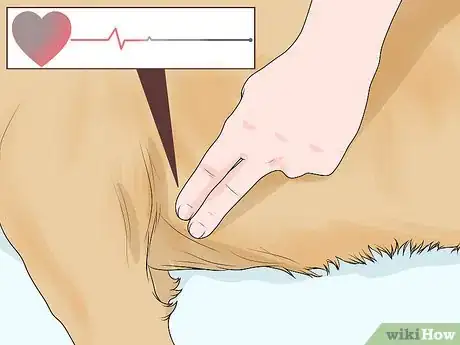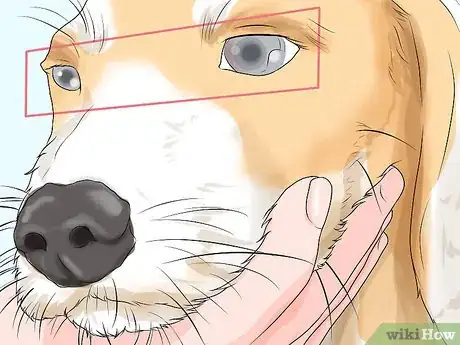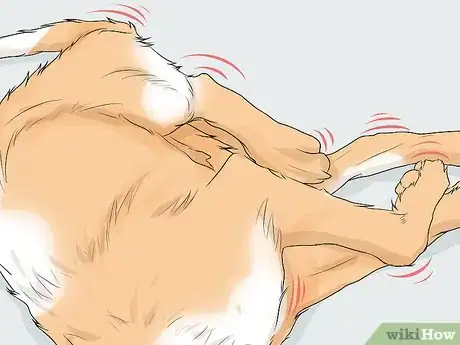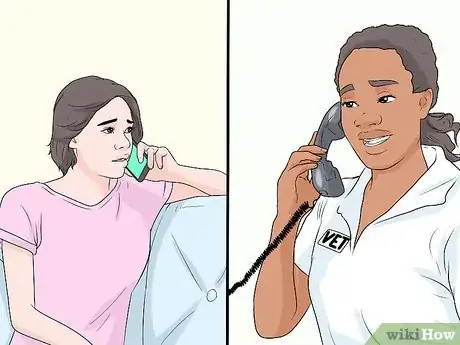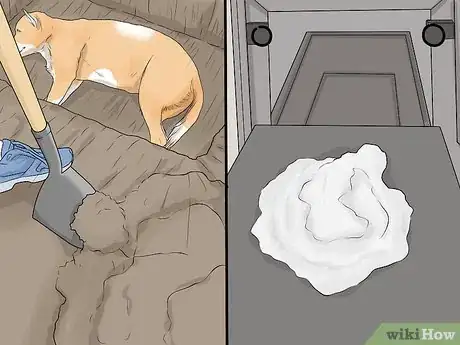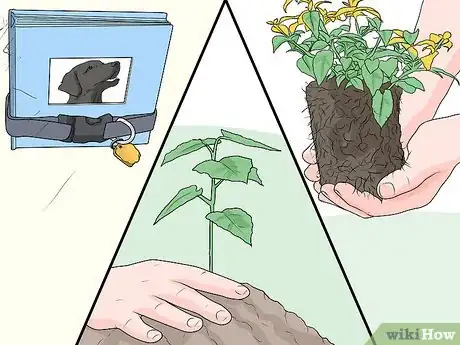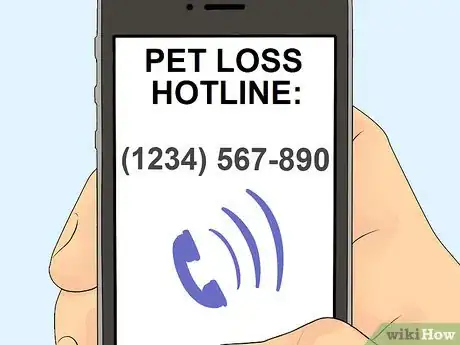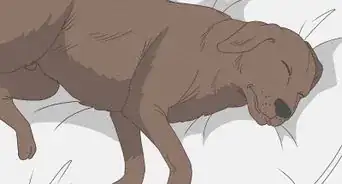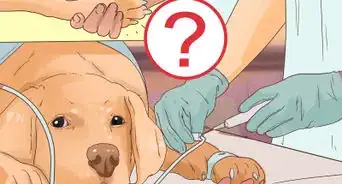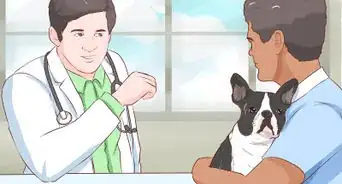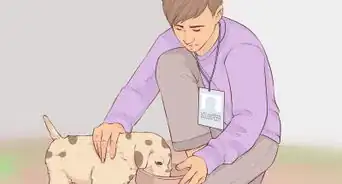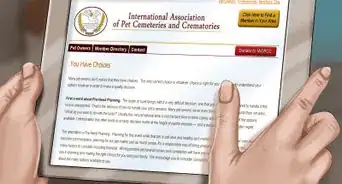This article was co-authored by Ray Spragley, DVM. Dr. Ray Spragley is a Doctor of Veterinary Medicine and the Owner/Founder of Zen Dog Veterinary Care PLLC in New York. With experience in multiple institutions and private practices, Dr. Spragley’s specializations and interests include non-surgical management of cranial cruciate ligament tears, Intervertebral Disk Disease(IVDD), and pain management in osteoarthritis. Dr. Spragley holds a BS in Biology from SUNY Albany and has a Doctor of Veterinary Medicine degree (DVM) from Ross University School of Veterinary Medicine. He is also a Certified Canine Rehabilitation Therapist (CCRT) through the Canine Rehab Institute as well as a Certified Veterinary Acupuncturist (CVA) through Chi University.
There are 8 references cited in this article, which can be found at the bottom of the page.
This article has been viewed 116,410 times.
Dogs are wonderful companions that add joy and happiness to a person’s life. Therefore, experiencing the death of a dog, whether the death is natural or through euthanasia (humane death), can be difficult. Knowing how to determine if your dog has passed away can help you better come to terms with the end of its life. Once you know your dog has passed away, learn how to cope with its death and remember the good times you had with your beloved companion.
Steps
Checking for Signs That Your Dog Has Died
-
1Determine whether your dog’s heart is beating. When a dog passes away, its heart will stop beating. To check for a pulse, place two fingers either on your dog’s chest where its heart is located (near the elbow joint), or high up on your dog’s inner thigh where a major artery is located.[1]
- If there is no pulse, then your dog has passed away.
- If your vet euthanizes your dog, they will check for a pulse after administering an overdose of a drug that gradually slows the heart until it stops.
-
2Check for breathing. Breathing may continue even after a dog’s heart has stopped. To check for breathing, hold a small mirror near your dog’s nostrils. If your dog is still breathing, a small amount of condensation will form on the mirror. You can also hold a tissue in front of the nose or mouth and see if it moves.[2]
- After at least several seconds, if you do not see condensation on the mirror or the piece of tissue doesn’t move, that means your dog is not breathing. If you know its heart has also stopped beating, you will know at this point that your dog has passed away.
- As your dog is taking its last breath, it may stretch its head back and stretch out its legs.[3]
Advertisement -
3Look at your dog’s eyes. When your dog has passed away, its eyes will be open.[4] The eyes will have a vacant look, as if your dog is staring into space. The pupils will be dilated (large and black) and your dog will not blink when you tap the corner of its eye.
-
4Watch for muscle twitches. Your dog’s body has electrical activity that helps coordinate muscle movement. Even after your dog’s breathing and heartbeat have stopped, its leg muscles may twitch for a little while. This does not mean your dog is alive. Instead, it means there is still some electrical activity in the muscles.[5]
- Eventually, all the electrical activity will run out and your dog’s muscles will stop twitching.
Coping with Your Dog’s Death
-
1Contact your vet. If your dog has died at home, call your vet for guidance on what to do next. You will probably be very emotional after knowing your dog has passed away, and it will be hard to think clearly. Your vet can help you organize your thoughts and emotions enough to decide what to do next.
- If your vet has euthanized your dog, they can talk to you at the vet’s office about making final arrangements for your dog’s body.
-
2Decide what you want to do with your dog’s body. Whether your dog has died at home or was euthanized at your vet’s office, you can decide to bury your dog or have your pet cremated.[6] Professional services are available for both options. If you’d like, ask your vet for recommendations on pet burial and cremation services.
- Be aware that home pet burials may not be allowed in your city because of public health concerns. Check your city’s laws on home pet burials before deciding on this option. If home burial is not an option, you can bury your dog at a pet cemetery.
- Cremation is a way to keep your dog’s remains without creating a public health risk by burying your dog in your yard.[7]
- If you do not want cremation or burial services, you could also have a professional animal removal service remove your dog’s body from your home.[8]
-
3Find ways to remember your dog. It is perfectly normal to grieve the loss of a pet. Through your grief, though, you can think about your dog in a way that makes you smile and feel better. You can remember your dog in several ways:[9]
- Remember the good times you had with your dog (play time, leisurely walks, quiet quality time).
- Create a memorial of your dog. Examples of memorials include scrapbooks, planting a tree, or planting some flowers.
- Make a donation in memory of your dog. Ask your vet or visit http://www.avmf.org/ for more information about making a donation.
-
4Contact a pet loss hotline. If your grief becomes too much for you to handle on your own, contact a pet loss hotline. Veterinary schools and various professional organizations sponsor pet loss hotlines to help pet owners cope with the death of their pet. Your veterinarian can provide you with pet loss hotlines in your area that you can contact.[10]
References
- ↑ http://www.peteducation.com/article.cfm?c=2+2099&aid=1077
- ↑ http://www.petplace.com/article/dogs/first-aid-for-dogs/nursing-care-for-sick-dogs/what-is-normal-in-dogs-heart-rate-breathing-rate-and-temperature
- ↑ http://hometoheaven.net/index.php?option=com_content&view=article&id=95&Itemid=140
- ↑ http://hometoheaven.net/index.php?option=com_content&view=article&id=95&Itemid=140
- ↑ http://hometoheaven.net/index.php?option=com_content&view=article&id=95&Itemid=140
- ↑ http://www.caninejournal.com/dog-cremation/
- ↑ http://www.pet-loss.net/funeral.shtml
- ↑ http://www.aspca.org/pet-care/general-pet-care/end-life-care#My_Pet_Is_Elderly_Pass_Away
- ↑ http://www.ghvsonline.com/the-next-step
About This Article
To determine if your dog has passed away, check it for a pulse by placing 2 fingers on its chest near the elbow joint or high up on its inner thigh. If you can't feel a pulse, your dog has likely passed away. You can also tell if your dog is alive by examining its eyes. If its eyes are open, dilated, and vacant looking, it has likely passed. To be certain, try tapping the corner of its eye to see if it blinks. For more advice from our Veterinary co-author, like how to cope with the death of your dog, scroll down.
